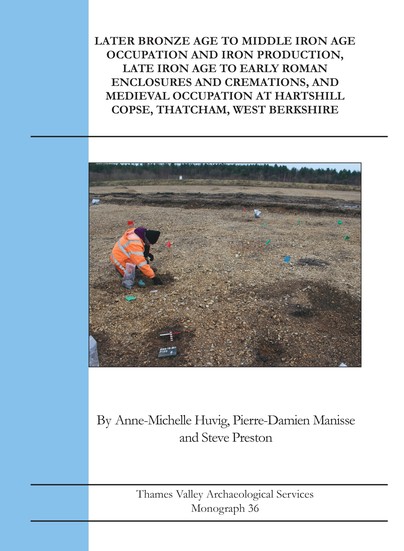Later Bronze Age To Middle Iron Age Occupation and Iron Production, Late Iron Age to Early Roman Enclosures and Cremations and Medieval Occupation at Hartshill Copse, Thatcham, West Berkshire (Paperback)
Series: TVAS Monograph Series
Pages: 246
ISBN: 9781911228462
Published: 14th June 2024
Casemate UK Academic
(click here for international delivery rates)
Need a currency converter? Check XE.com for live rates
Excavations in advance of gravel extraction on a 10ha site revealed a landscape occupied from the Later Bronze Age to the early Roman period, with later use in the Medieval period. The site published here complements a significant excavation to the south which had produced evidence for the earliest iron working in Britain. The results help to set the south site into its local landscape context, and also cover a longer timespan.
A single Middle Bronze Age pit was followed by numerous Late Bronze Age to Early Iron Age pits, best classed as a dispersed open settlement. Finds of smelting slag from this period confirm the early dating for the iron working found to the south. Middle and Later Iron Age features also mostly comprised pits and postholes with no clear structural associations, although a ring ditch and up to a dozen post-built roundhouses can be projected and the continuation of a large enclosure from the earlier site. An area of industrial activity included more iron production from the 6th century BC onwards. Three pit alignments were also identified, one containing a density of iron slag. One pit also contained a quantity of acorns, a rarity on British sites.
Two late Iron Age urned cremations were identified, and one Roman, and several deposits of pyre debris may be of either period. Late Iron Age to early Roman ditches represented three phases of an enclosure, likely part of a wider organization of the landscape at this time. Two iron-smelting hearths were identified, one of which contained in situ slag from the last firing of the furnace. All of the Roman deposits dated from the mid-1st to 2nd century AD. This early abandonment is in contrast to the later Roman date for the few Roman features to the south, so that a southwards shift in the focus of activity seems to be indicated rather than outright abandonment.
The Medieval period was represented by a small isolated farm dated to the 11th to 12th centuries AD, although economic evidence was very sparse.
The site's chronology is supported by an extensive radiocarbon dating programme and this volume includes reports on substantial assemblages of pottery (mostly prehistoric), metallurgical residues, and charred plant remains, but soil conditions were not favourable to the survival of most other classes of finds.









